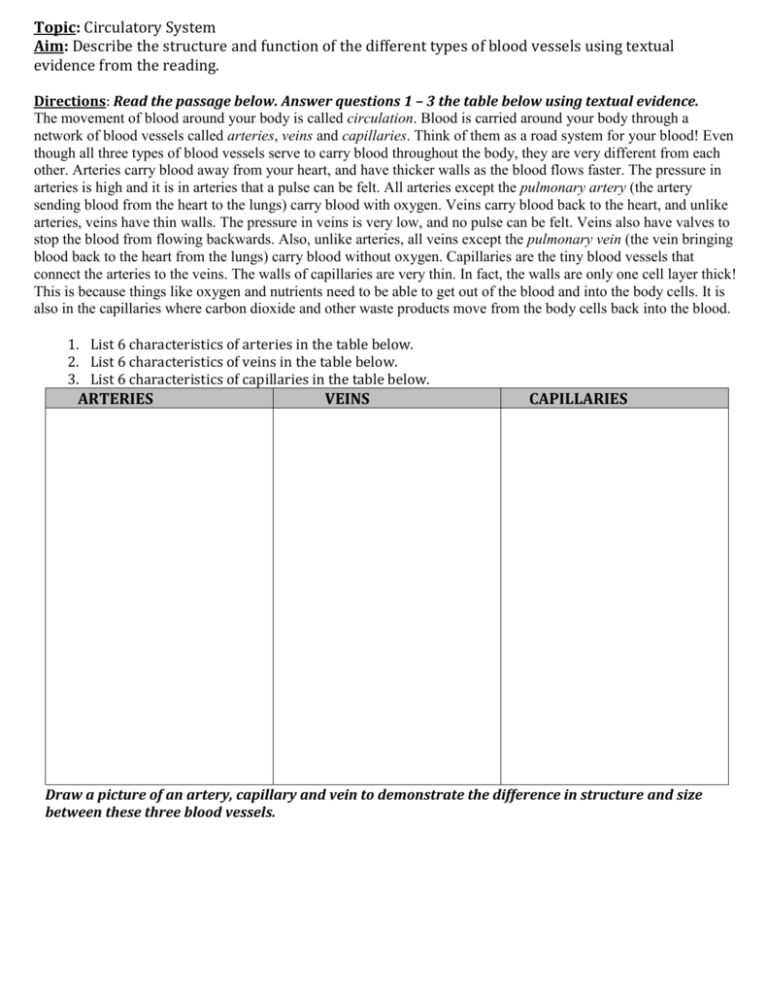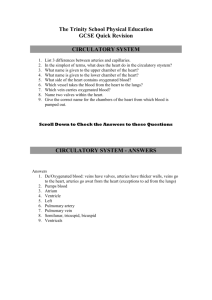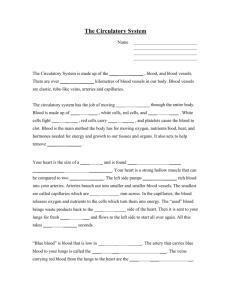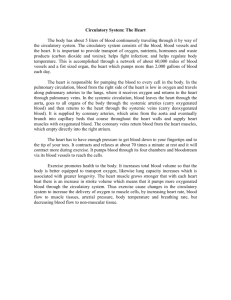arteries veins capillaries
advertisement

Topic: Circulatory System Aim: Describe the structure and function of the different types of blood vessels using textual evidence from the reading. Directions: Read the passage below. Answer questions 1 – 3 the table below using textual evidence. The movement of blood around your body is called circulation. Blood is carried around your body through a network of blood vessels called arteries, veins and capillaries. Think of them as a road system for your blood! Even though all three types of blood vessels serve to carry blood throughout the body, they are very different from each other. Arteries carry blood away from your heart, and have thicker walls as the blood flows faster. The pressure in arteries is high and it is in arteries that a pulse can be felt. All arteries except the pulmonary artery (the artery sending blood from the heart to the lungs) carry blood with oxygen. Veins carry blood back to the heart, and unlike arteries, veins have thin walls. The pressure in veins is very low, and no pulse can be felt. Veins also have valves to stop the blood from flowing backwards. Also, unlike arteries, all veins except the pulmonary vein (the vein bringing blood back to the heart from the lungs) carry blood without oxygen. Capillaries are the tiny blood vessels that connect the arteries to the veins. The walls of capillaries are very thin. In fact, the walls are only one cell layer thick! This is because things like oxygen and nutrients need to be able to get out of the blood and into the body cells. It is also in the capillaries where carbon dioxide and other waste products move from the body cells back into the blood. 1. List 6 characteristics of arteries in the table below. 2. List 6 characteristics of veins in the table below. 3. List 6 characteristics of capillaries in the table below. ARTERIES VEINS CAPILLARIES Draw a picture of an artery, capillary and vein to demonstrate the difference in structure and size between these three blood vessels. Topic: Circulatory System Aim: Explain the function and structure of the circulatory system. Watch the short video about the circulatory system to answer the questions below. 1. Describe the function of the circulatory system. 2. How is the heart divided? ______________________________________________________________________________________________ 3. Identify the different chambers. _________________________________________________________________________________________ 4. What kind of blood is found on the right side of the heart? ___________________________________________________________ 5. Identify the blood vessel that transports blood into the right atrium. _______________________________________________ 6. Identify the blood vessel that blood from the right ventricle enters. ________________________________________________ 7. Identify the organ that the pulmonary artery transports blood to. ___________________________________________________ 8. What happens to the blood in the lungs? _______________________________________________________________________________ 9. Which side of the heart does oxygenated blood from the lungs travel to? __________________________________________ 10. Identify the blood vessel that carries oxygenated blood back to the heart. _________________________________________ 11. Identify the largest artery in the body that transports oxygenated blood to the rest of the body. _________________ FUNCTION OF THE HEART: TYOE IF MUSCLE FOUND IN THE HEART: ______________________________________________________________________ PARTS OF THE HEART BLOOD FLOW IN THE HEART BLOOD VESSELS ATTACHED TO THE HEART ________________________________________________________: carry DEOXYGENATED blood from the rest of the body back to the right side of the heart ________________________________________________________: carry DEOXYGENATED blood from the right side of the heart to the lungs ________________________________________________________: carry OXYGENATED blood from the lungs to the left side of the heart. ________________________________________________________: largest artery in the body - Carries OXYGENATED blood from the left side of the heart to the rest of the body BLOOD FLOW THROUGH THE BODY Label the numbered structures in the diagram below.










